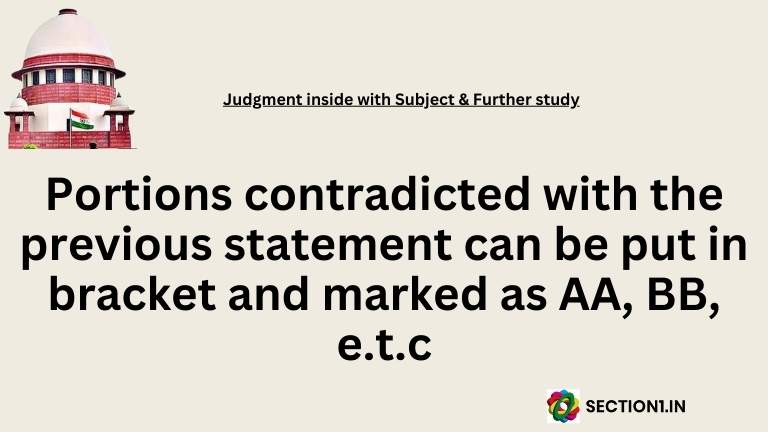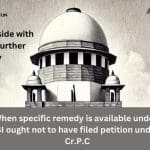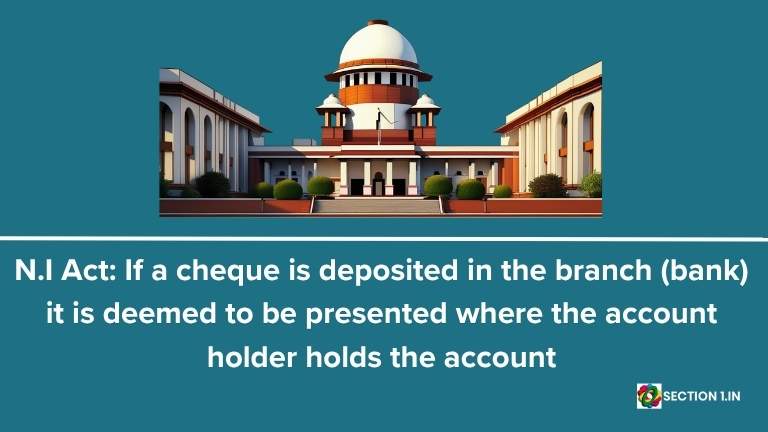Appellant convicted for murder by Trial court confirmed by Hon’ble High Court
1. The appellant has been convicted for the offence punishable under Section 302 of the Indian Penal Code, 1860 (for short, ‘the IPC’) and has been sentenced to undergo imprisonment for life and pay a fine of Rs.2000/-. In default of payment of the fine of Rs.2000/-, he has been sentenced to undergo rigorous imprisonment for one year. The appellant’s conviction was rendered by the Sessions Court (Court of Additional Sessions Judge, Shahdara, Delhi) and confirmed by the impugned judgment by the High Court of Delhi.
Facts leads to this appeal
2. The name of the deceased is Dharminder. The appellant was a neighbour of the deceased. On 12th July 1995, at about noon, the appellant came to the residence of the deceased and called upon him to accompany him. PW-3 (mother of the deceased) enquired with the appellant where they were going. The appellant replied that they would return soon, and they went together by holding each other’s hands. At that time, PW-1 (father of the deceased) was in the house, but he was sleeping as he had done night duty as a security guard. As the deceased did not return till 1 pm, PW-3 went to the appellant’s house to enquire about the whereabouts of the deceased. At that time, the appellant told PW-3 that the accused had gone to watch a movie. PW-3 had to wait for the whole night. As the deceased did not turn up, on 13th July 1995 at 7 am, PW3 again visited the appellant’s house to enquire. The appellant’s mother told PW-3 that the appellant had gone out for work and he would be back by 9 pm. The parents of the deceased searched for the deceased the whole day. They went to the appellant’s house again at 8 pm. When they met the appellant, they found that the appellant gave inconsistent answers. Initially, the appellant stated that the deceased had gone to purchase manjha (a thread used for flying kites). Thereafter, he stated that he had left the deceased on the road. Lastly, the appellant stated that he had left the deceased at his residence. As the answers given by the appellant were not satisfactory, the parents of the deceased threatened the appellant to file a police complaint. Ultimately, at 10 pm, PW-1 went to the Police Station and lodged a missing report. After lodging the missing report, when the Police, accompanied by the parents of the deceased, went to the house of the appellant, they found that the appellant and his father had absconded. On 14th July 1995 at about 8 am, PW-5, who was the cousin of the deceased, told PW-1 that the dead body of the deceased was lying in a bathroom on the terrace of a particular building. PW-1 visited the spot and identified the body of the deceased. He found that a rope was tied to the neck of the deceased, and the hands were tied on the back side. A First Information Report was registered for the commission of an offence punishable under Section 302 of the IPC. The case rests on circumstantial evidence.
Consideration
Case is on circumstantial evidence
5. The prosecution’s case is based on circumstantial evidence. We find from paragraph 35 of the impugned judgment of the High Court that the following circumstances, forming a part of the chain of circumstances, were held to be proved. The said circumstances are as follows:
“35 ..,, a. That PW-3, mother of the deceased was a last seen evidence of the appellant taking the deceased along with him from his residence on 12th July 1995 at 12 noon.
b. The testimonies of PW-1 and PW3 that they repeatedly went to the residence of the appellant so as to know the whereabouts of their son but the appellant gave evasive replies to misguide them.
c. The proximity of time of the death of the deceased with the time of the deceased leaving his residence.
d. The conduct of the appellant in absconding from his residence after he was told that the Police Report would be lodged against him for not disclosing the whereabouts of the deceased.
e. The recovery of blood stained clothes of the appellant at the instance of the appellant.
f. The appellant had suffered injuries on his own person as the MLC proved on record as Ex.PW22/A, which remained unexplained by the appellant forming an additional link in the chain of circumstantial evidence to prove his guilt.”
PW3 evidence is hearsay evidence
6. The evidence of PW-1 on the last seen together theory cannot be believed as he stated that he was sleeping when allegedly the appellant took the deceased with him. His statement that PW-3 had visited the appellant’s house at 1 pm is hearsay evidence as he did not accompany his wife. Thereafter, he deposed that:
a) At about 8 pm, he, along with PW-3, visited the house of the appellant to enquire about the whereabouts of the deceased. At that time, the appellant was not present;
b) On 13th July 1995, at about 7 am or 7:30 am, he and PW-3 went to the appellant’s house to enquire about the deceased’s whereabouts. At that time, the parents of the appellant told them that the appellant had gone to attend his duty and would be back by 9 pm;
c) On the evening of 13th July 1995, he and PW-3 again visited the appellant’s house at about 6 pm. At that time, the appellant told them that he had left the deceased near their house, and
d) On the same day, at about 8 pm or 9 pm, he, along with the Police, went to the appellant’s house when it was found that the appellant and his father had run away from their house.
PW.1 statement is full of omission
7. What is stated by PW-1 in terms of clause (a) above is an omission. He did not depose that the appellant gave evasive answers when he visited his house.
Motive is absent
9. When PW-3 was asked a question for what reasons the appellant may have killed her son, she answered that there was no enmity between the deceased and the appellant, but she suspected that the appellant had killed her son as the appellant had taken her son with him. Therefore, even according to the case of the PW-3, the motive for the commission of the offence was absent. This is very relevant as the case is based on circumstantial evidence.
Omissions amount to contradiction
10. There are significant improvements and omissions in the evidence of PW-3. The omissions are so relevant that they become contradictions in view of the Explanation to Section 162 of the Code of Criminal Procedure, 1973. Thus, it is very difficult to accept the testimony of PW-3 as reliable. PW-1 is not a witness to the theory of last seen together. Therefore, it is not possible to hold that the theory of last seen together was proved by the prosecution beyond a reasonable doubt. Even the finding of the High Court that the appellant gave evasive replies to misguide the parents of the deceased cannot be sustained. Therefore, two out of five circumstances held as established were not established beyond a reasonable doubt. When the prosecution case is based on circumstantial evidence, the circumstances from which the conclusion of guilt is to be drawn should be fully established. There must be a chain of circumstances so complete as not to leave any ground for any conclusion inconsistent with the innocence of the accused. In this case, two significant circumstances forming the chain have not been established.
Portions contradicted with the previous statement can be put in bracket and marked as AA, BB, e.t.c
11. Before we part with the judgment, we must refer to a peculiar practice followed by the Trial Court. PW-1 and PW-3 were confronted in the cross-examination with their statements recorded under Section 161 of the CrPC. In the depositions, it is mentioned that the attention of the witness was invited to a particular portion of the prior statement. After recording the answer of the witness, the portion of the prior statement used to contradict the witness has been reproduced in brackets. The law is well settled. The portion of the prior statement shown to the witness for contradicting the witness must be proved through the investigating officer. Unless the said portion of the prior statement used for contradiction is duly proved, it cannot be reproduced in the deposition of the witnesses. The correct procedure is that the Trial Judge should mark the portions of the prior statements used for contradicting the witness. The said portions can be put in bracket and marked as AA, BB, etc. The marked portions cannot form a part of the deposition unless the same are proved.
12. For the reasons recorded above, the conviction and sentence of the appellant cannot be sustained. Accordingly, the impugned judgments are quashed and set aside, and the appellant is acquitted of the offences alleged against him. The Appeal is accordingly allowed. Bail bonds furnished by the appellant stand cancelled.
Party
Vinod Kumar – State (Govt. of NCT of Delhi) – Criminal Appeal No. 2482 of 2014 – 2025 INSC 209 – February 13, 2025





